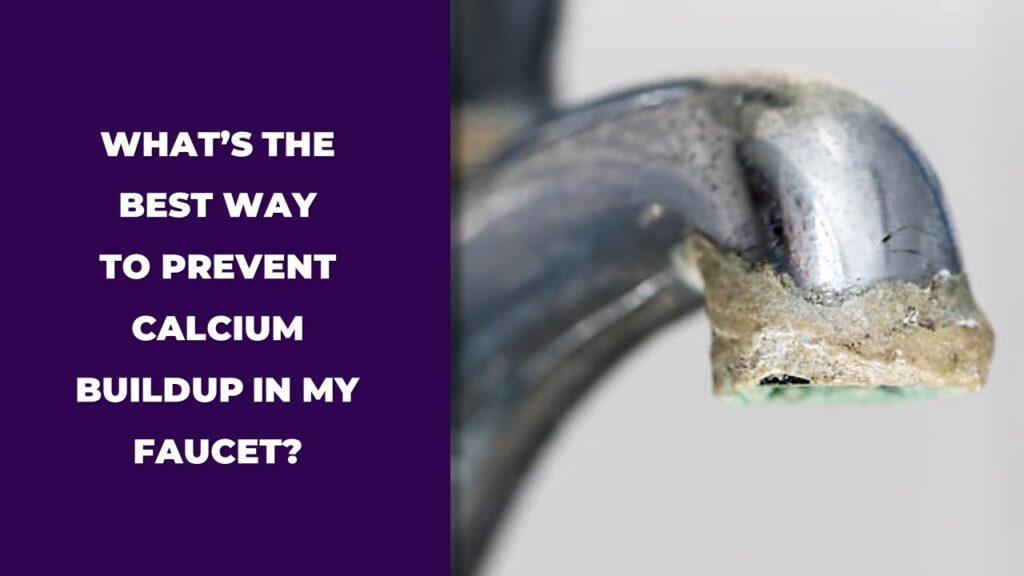
The best way to stop that stubborn calcium buildup faucets is to install a water softener. It works by taking out minerals like calcium and magnesium from your water before they can stick to your faucet and leave those ugly white stains. If that’s not something you can do right now, no worries. You can still manage it by wiping your faucet down after every use, giving it a vinegar soak when it looks crusty, and even using a little silicone grease to keep things smooth.
We’ll talk about why this white stuff keeps showing up in the first place, how it can mess up your faucet if you ignore it, and what you can actually do about it without spending a fortune. Whether you want a quick fix or a long-term solution, this article’s going to walk you through it.
What Causes Calcium Buildup on Faucets?
Calcium buildup on faucets happens when hard water dries and leaves behind minerals like calcium and magnesium. These minerals stick to your faucet, forming a white, chalky layer that just keeps getting worse over time if you don’t do something about it. It’s that simple—hard water plus time equals buildup.
If you’ve ever seen your faucet looking dull or crusty, that’s limescale, and it’s a pain. The water dries up, but the minerals stay. The more you use the faucet, the more buildup you get. It’s worse if you live in an area with hard water. And yeah, you can buy kitchen faucets for hard water, but they won’t stop it entirely; they just help a bit.
Here’s what causes the problem:
- Hard water with high calcium and magnesium levels
- Water droplets drying on faucet surfaces
- No regular cleaning to wipe off the deposits
- Certain faucet finishes (like chrome) showing buildup faster
- Repeated exposure, using the faucet every day speeds it up
How Does Calcium Buildup Affect Faucets?
Calcium buildup can mess up your faucet more than you’d think. It starts with a bit of white crust, and before you know it, your faucet looks old, the handles get stiff, and the water barely trickles out. If you ignore it, you might even end up with leaks or have to replace the faucet entirely.
Here’s how it really affects things:
- The aerator, the little screen where water comes out, gets clogged. That makes your water flow all weird, like spraying sideways or barely coming out at all.
- The seals and cartridges inside your faucet don’t like hard water either. The minerals wear them down, so they start leaking.
- Your faucet’s surface gets rough, discolored, and feels like sandpaper when you touch it.
- Even the handles can get stuck. The buildup gets inside the moving parts, making them hard to turn.
- Worst case, the minerals get into your pipes too. That can mess up your whole plumbing system, lower water pressure, and even lead to costly repairs if it gets bad enough.
So yeah, it’s not just an ugly problem, it’s one you’ll want to fix before it gets out of hand.
The Most Effective Solution: Install a Water Softener
The best way to stop calcium buildup in its tracks is to install a water softener. It’s the go-to solution because it takes out the calcium and magnesium from your water before they can cause trouble. That way, your faucet, and the rest of your plumbing, stays cleaner for longer.
A water softener is kind of like a bodyguard for your water system. Instead of scrubbing and soaking your faucet every week, you let the softener do the work for you. It’s a long-term fix that protects more than just your faucets; it helps with appliances, pipes, and everything in between.
What Is a Water Softener and How Does It Work?
A water softener works using ion exchange. It swaps out calcium and magnesium ions in your water and replaces them with sodium or potassium ions. The result? Soft water that doesn’t leave those nasty white marks all over your faucet.
Benefits of a Water Softener for Your Faucets and Plumbing
Here’s what a water softener can do for you:
- Stops limescale from building up inside your faucet
- Keeps water flowing smoothly through your pipes
- Cuts down on wear and tear in appliances like dishwashers and washing machines
- Saves you time and effort scrubbing off mineral deposits
Types of Water Softeners and Choosing the Right One
Not all water softeners are the same. You’ve got:
- Salt-based systems that use salt to swap out minerals
- Salt-free systems that condition the water without salt
- Magnetic or electronic systems that change how minerals behave
When you’re picking one, think about how hard your water is, how much water your household uses every day, and what kind of budget you have for installation and upkeep.
Maintenance Tips for Water Softeners
Once you get a water softener, you can’t just set it and forget it. To keep it working properly, you’ll need to check the salt levels regularly and refill them when they run low. If the salt runs out, the system won’t be able to soften your water.
Every few months, it’s also a good idea to clean the resin tank. This helps prevent buildup that could affect performance. And don’t forget to schedule a plumber for a check-up once in a while.
They can make sure everything is running smoothly and catch any small issues before they turn into bigger problems.
Easy DIY Methods to Prevent Calcium Buildup
If you’ve ever seen that white, crusty stuff on your faucet, that’s calcium buildup. And if you’ve got hard water in your home, it’s just going to keep coming back unless you do something about it. The good news? You don’t need fancy tools or expensive products. You can actually keep it under control with a few simple tricks—things like wiping your faucet, using a vinegar solution, applying a bit of silicone grease, or even adding a small filter.
Here’s what works if you want to stop calcium from building up in the first place:
Regular Cleaning Techniques
Wiping down your faucet regularly is the easiest way to keep calcium away. Every time you use the sink, just grab a dry cloth and wipe the faucet down—that stops water droplets from drying into limescale. Once a week, mix two tablespoons (about 30 ml) of white vinegar with one cup (240 ml) of warm water. Dip a soft cloth in the mix and wipe down the faucet, especially around the spout and handles. If you see a bit of buildup starting, don’t wait. Just rub a little plain vinegar on it with a cloth and it’ll come right off. After cleaning, rinse with water and dry the faucet.
If you live in a hard water area, it might help to use kitchen faucets made for hard water—they can resist scale a bit better, but you’ll still want to keep up with regular cleaning.
Protective Coatings for Faucets
You can also try adding a thin layer of silicone grease—it helps stop water from sticking around in the first place. A pea-sized amount, about 1/4 teaspoon, is enough. Rub it onto a clean, dry faucet, focusing on the spout and base. Let it sit for five minutes, then wipe off the extra with a dry cloth. Do this every couple of months. There are also sprays you can buy that create a water-resistant barrier, but check the label to make sure they’re safe for your faucet’s finish.
Water Filter Attachments for Faucet Protection
If you can’t get a water softener, a faucet-mounted filter can help. These filters screw onto the end of the faucet and catch some of the minerals before they get a chance to leave deposits behind. They won’t stop everything, but they’ll help. Most filters should be replaced every two to three months, or after they’ve filtered about 100–200 gallons (400–800 liters) of water. It’s a small step, but it can make a difference in how much limescale you get.
How to Remove Existing Calcium Buildup from Faucets
If your faucet is already covered in that white, crusty stuff, don’t panic—it happens. The good news is you can usually clean it off without calling a plumber. The trick is soaking it in the right stuff for the right amount of time and using the right tools to scrub it clean.
Here’s how to get it done:
Step-By-Step Vinegar Soak Method
First, grab half a cup (120 ml) of white vinegar, a plastic sandwich bag, and a rubber band. Pour the vinegar into the bag, fit it over the faucet spout so the tip is fully submerged, and secure it with the rubber band. Let it sit for at least an hour—if the buildup is thick, leave it overnight. After the soak, take off the bag and wipe the faucet with a soft cloth. Most of the crust should come right off. If it’s stubborn, you can soak it again.
Scrubbing Tips and Tools
For the spots that won’t budge, grab a soft toothbrush, a sponge, or a cloth. If you need a little extra scrubbing power, sprinkle one teaspoon (5 grams) of baking soda onto the damp cloth and gently rub the area. Don’t use steel wool or harsh scrubbers—they’ll scratch your faucet. Once you’re done, rinse everything with water and dry it well.
When to Call a Plumber for Severe Buildup
If the water flow is still slow after cleaning, or if the faucet drips or leaks, you might have buildup inside the faucet or even in the pipes. That’s when it’s smart to call a plumber. They can take the faucet apart, clean the inside, and check for any hidden issues. Sometimes you just need a pro to get things back to normal.
How to Test for Hard Water in Your Home
Testing for hard water in your home is easier than you might think. You can use a simple DIY test with basic supplies, get a free test kit from a water softener company, or just look for the common signs of hard water in your daily life.
Knowing if you have hard water helps you figure out if calcium buildup is going to be a problem—and how serious it might get. Let’s break down how to check for hard water:
DIY Hard Water Testing Kit
You can test your water at home with a basic kit. You’ll find these kits at hardware stores or online. They usually cost around $10 to $20 and come with test strips that measure hardness in grains per gallon (GPG) or parts per million (PPM). To use it, fill a small cup with tap water, dip the strip in for a few seconds, and compare the color change to the chart included in the kit. If your water tests at 7 GPG (120 PPM) or higher, it’s considered hard, and you’ll want to take action to prevent calcium buildup.
Free Tests from Water Softener Companies
Some water softener companies offer free water testing to help you decide if you need a softener. Just search for “free water test near me,” or visit the websites of brands like Culligan, RainSoft, or Kinetico. They’ll usually send a sample kit or have a local rep test your water at home. It’s a good way to get a professional opinion, especially if you’re already considering a softener.
Signs of Hard Water in Daily Life
You don’t always need a test strip to know you have hard water. Watch for these signs:
- White, crusty deposits on faucets and showerheads
- Soap that doesn’t lather well, or leaves a sticky residue
- Cloudy glassware after washing
- Rough or dry-feeling skin after showers
- Stiff, scratchy laundry that feels hard after washing
If these sound familiar, you probably have hard water—and calcium buildup is on its way if you don’t act.
Long-Term Solutions: Keeping Faucets Calcium-Free
If you’re tired of scrubbing off calcium every month, you’ll want to think about long-term fixes. The best way to stop calcium buildup for good is by fixing the problem at the source. This means regular plumbing checks, adding whole-house filters, or upgrading to better faucet materials. Let’s look at the options:
Regular Plumbing Maintenance
Checking your plumbing regularly can catch small problems before they turn into big ones. Once a year, have a plumber inspect your faucets, pipes, and water heater for signs of limescale. If you have a water softener, make sure it’s working right. Catching buildup early keeps your system running smoothly, so you won’t have to deal with clogged pipes or ruined fixtures.
Investing in Whole-House Filtration Systems
For serious hard water problems, a whole-house filtration system might be worth it. These systems filter out minerals like calcium and magnesium before the water reaches your faucet. They’re not cheap—prices can range from $500 to over $3,000, depending on the size of your home and the type of system. But they protect your entire plumbing system, not just one faucet, and they help prevent calcium buildup everywhere, from your kitchen sink to your showerhead.
Upgrading Faucets to Corrosion-Resistant Materials
If you’re ready for a long-term fix, consider upgrading to a faucet that’s built to handle hard water. Look for options like stainless steel, PVD-coated finishes, or solid brass with protective coatings. These materials are less likely to corrode or show buildup. While they won’t stop hard water deposits entirely, they’re easier to clean and won’t get damaged as quickly as cheaper finishes.
Conclusion
Calcium buildup on your faucet is a frustrating but fixable problem. The best way to prevent it is to stop it at the source, by installing a water softener or a whole-house filtration system that removes minerals like calcium and magnesium. If that’s not an option, regular cleaning with vinegar, wiping down the faucet after each use, and applying protective coatings can make a big difference.
Testing for hard water is simple and worth doing. Whether you use a DIY kit, get a free test from a company, or just watch for signs like cloudy glassware and dry skin, knowing your water’s hardness level helps you choose the right solution.
Taking care of your faucet isn’t just about keeping it shiny. It’s about protecting your plumbing, saving money on repairs, and making your life a little easier. With the right steps, you can keep calcium buildup under control and enjoy a faucet that works like it should, year after year.
Related FAQs
What is the difference between a water softener and a filter for preventing calcium buildup?
A water softener removes calcium and magnesium from all your water, while a filter only reduces minerals at the faucet. Softeners tackle the problem at the source, while filters offer limited protection.
How often should I clean my faucet to prevent limescale?
Wipe your faucet dry after every use, and do a deeper clean with vinegar once a week. If you live in a hard water area, you might need to clean more often to stay ahead of buildup.
Can I use vinegar regularly without damaging my faucet finish?
Yes, but be careful. Vinegar works well for cleaning, but it can dull or harm delicate finishes like bronze or matte black. Always test a small area first, and use it no more than once a week.
Is there a natural alternative to a water softener for preventing calcium buildup?
While nothing fully replaces a softener, regular cleaning with vinegar and using faucet-mounted filters can help reduce calcium deposits. You can also apply silicone grease as a barrier, but it’s not a complete solution.
Will a water softener solve all hard water problems in my home?
A water softener fixes most hard water issues, like limescale buildup, soap scum, and dry skin. But for other concerns like iron, bacteria, or chlorine, you may still need additional water filtration.

Dylan Foster is a family man with years of hands-on experience in plumbing, household maintenance, and fixing everyday issues around the home. A former plumber, Dylan knows what it’s like to deal with tricky leaks, worn-out parts, and all the little problems that pop up in a house. From plumbing repairs to kitchen fixes and garden hose setups, he’s done it all. Dylan shares real-world solutions to help others keep their homes running smoothly and avoid costly mistakes.




